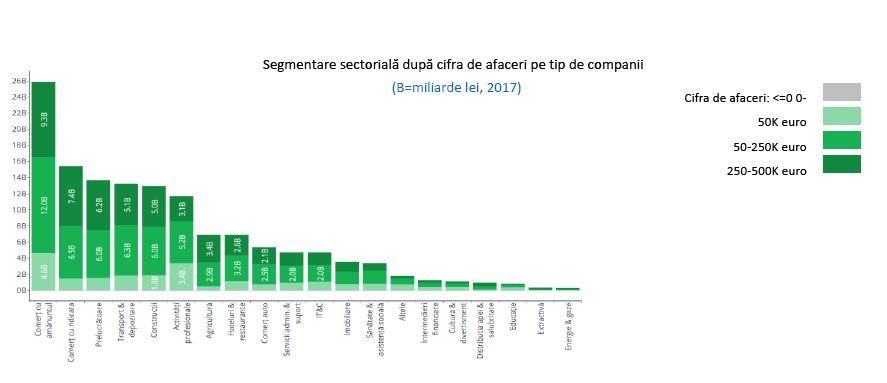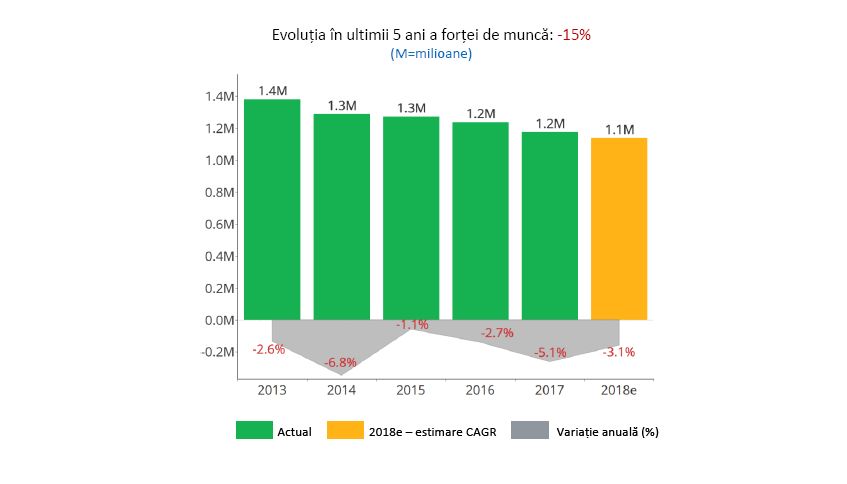At the level of the financial data for the year 2017, Romania recorded 511,800 active micro-companies with an aggregate turnover of 139.1 billion lei (an average of 271,785 RON per company), employing 1.1 million people (2.4 employees per company) earned a consolidated profit of RON 28 billion (20% of the turnover achieved by an average of RON 54,708 per company).
Microenterprises are a market segment in creation, showing a positive year-on-year growth - turnover by 5.2% compared to 2016 and by 23.8% as compared to 2013, to 139.1 billion lei in 2017. Instant Factoring forecasts the continuation of this year's growth trend at around 4%, rising to 145 billion ROL. Microenterprises have a 10% share of the business volume generated by all companies in the economy.

Trade, the easiest and most accessible field of activity
The easiest and most accessible field of activity remains commerce, underlining, at least at this level, that the local economy keeps the basic consumption pillar. In 2017, Retail Revenue generated 25.9 billion ROL volumes to 97.9K active companies, followed by Wholesale Wholesale with ROL 15.4 Billion and 39.4K Active Companies, and only halfway up to the first place, Manufacturing 13.7 billion lei and 37.3 thousand active companies.
Other sectors accessed by the entrepreneurs are Transport and Construction, with a consolidated turnover of ROL 13.2 billion and 39.4K active companies, ROL 12.9 billion and 50K active companies.
All of these are, in fact, volatile sectors at a future major economic instability. 68.9% of the turnover of microenterprises in Romania, equivalent to 81 billion lei, represents the first 5 areas of activity.

Bucharest, Cluj, Timis, Constanta and Ilfov have the most dynamic business ecosystem
Bucharest has the most dynamic business environment accounting for almost a quarter of the total, with 106.7K of active companies in 2017, which generated 19.5% of the cumulated volume of the analyzed segment, 26 billion lei. The districts of Cluj (5.4%), Timis (4.4%), Constanta (4%) and Ilfov (3.9%) are located at a considerable distance, according to the business volume (you have the number of active companies). These amount to a third, 37.2% of the total national turnover, namely 39%, 200K of companies active in Romania in 2017.
The present situation, as well as trends that have been in place for years, call for urgent measures to stimulate the development of local economies in the province. It can also be added that no city in Moldova or Oltenia is in the top places, Iasi ranks 9th with 2.97% and Dolj on 11 with 2.71%.
A fifth of active companies had zero results or even negative results
If in 2017 511,700 microenterprises were active, one fifth of them, 107,6K, had a raw result equal to zero or even negative. In contrast, companies ranging in the gross profit margin of 50K -250K, in a share of 21%, generated 45% of the total business volume, representing the largest segment in Romania.
The distribution of companies by age is balanced, just over a quarter of microenterprises are less than 5 years old, 24% are between 5 and 10 years, 20% between 10 and 15 years, 13% between 15 and 20 years, and 17% over 20 years.
Workforce declined from year to year and will continue to grow in 2018
The workforce has fallen by 5% compared to 2016 and by almost 15% compared to 2013, to 1.11 million employees in 2017, accounting for about 23% of the number of jobs registered nationwide at the end of the year 2017. For 2018, we estimate the decline in the workforce to just over one million employees based on accelerated migration and automation processes.

Retail employs most people
Of the total workforce of almost 1.1 million employees, Retail is the leader with 168K employees (15.1%), followed by Manufacturing (158K and 14.2% respectively) and Construction (130K and 11% respectively) of the total).
The degree of specialization of the workforce is directly proportional to the average cost per employee, placing first the sectors: Extractive, Energy & Gas and Professional Activities. While labor productivity has the best results in the sectors: Wholesale, Energy & Gas and Agriculture.
The top of the most dynamic cities is maintained, the only replacement being Ilfov and Arges, as follows: Bucharest - over 191K employees, 17.2% of the total, Cluj (5.1%), Arges (4.9%), Constanta 4.4%) and Timis (4.1%). The active micro-enterprises in these counties had almost 440K of employees, ie 35.8% of the total.
"Microenterprises remain the most dynamic sector in the economy and are the fastest adaptable and also vulnerable to economic development and coverage of various market niches. Their economic impact remains unfortunately still low, accounting for only 10% of the aggregate turnover of Romanian companies, especially due to the inaccessibility of financial resources that will allow them to make the jump from the embryonic to a higher class development. Romania is adapting, albeit heavier, the global development trends of starting-up companies' start-up ecosystems with start-ups with financing solutions, business accelerators, mentoring for entrepreneurs, workshops of specialized trainings, communities specific support. For an economy to have a future, we need to invest in small companies and give them a chance to grow, "said Cristian Ionescu, CEO and President of Instant Factoring.





























